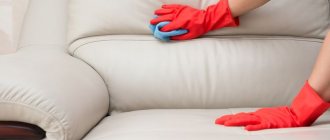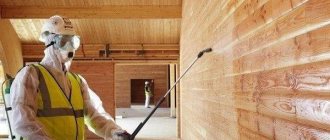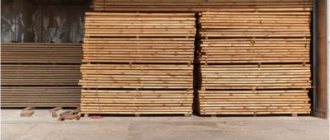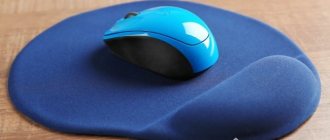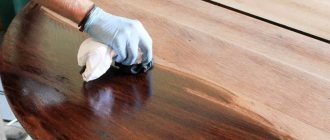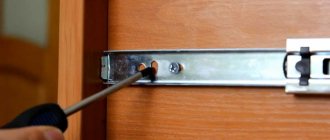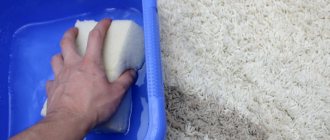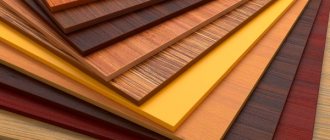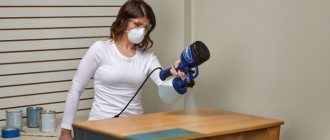How to clean a wooden kitchen without the risk of damaging the surface? A little earlier we talked about washing facades made of various materials, and now we’ll talk in more detail about such a base as wood. Only sometimes you have to deal not with the base, but with similar headsets entirely. To prepare for cleaning capricious materials that are unstable to all external influences, it is better to enlist the help and support of video materials and this article.
How to care for natural wood furniture
Wood furniture should not be wiped with a wet or even damp cloth, because... she is very sensitive to moisture.
In order to cause minimal damage to your favorite furniture, cleaning should be done only with cloth or a dry flannel cloth.
- Particular care should be taken when handling furniture made from valuable wood. Such furniture must be limited in contact with very hot and very cold dishes, because... she may leave marks. In order to avoid this, you need to use various stands, tablecloths, etc.;
- Veneered furniture should be wiped with a slightly damp cotton cloth. Among other things, there are a number of delicate products. which will help in caring for this type of furniture;
- To care for wooden furniture, products are now available for sale in the form of liquids, aerosols, pastes and special wipes. Also, do not use solvents on this type of furniture.
- Cleaning preparations for such furniture are: oil-based and wax-based:
- Oil-based products are great for cleaning and protecting any wooden surfaces. Oil cleaning compositions gently care for wood, efficiently remove dirt, give shine and fresh color;
- Wax-based products are used for polishing purposes. Using wax products you can prevent the formation of dirt, scuffs and small scratches. They do not leave streaks, have dust-repellent properties and have an antistatic effect, which together helps keep polished furniture in perfect condition.
If you are afraid of products containing chemicals, try any of the presented folk remedies
The best way to remove dust on wooden furniture with an uneven surface is a special furniture brush.
In order to clean wooden furniture, you need to mix 1 tbsp. spoon (15 ml) olive oil and 2 tbsp. tablespoons (30 ml) lemon juice or vinegar. Spray the mixture from a plastic spray bottle or dampen a clean, soft cloth with it and wipe the wood furniture. Vinegar removes dirt from wooden surfaces, and oil prevents them from drying out.
- In order to polish wooden furniture, you need to take lemon oil - because it restores shine and acts as an antiseptic. To get a natural shine for furniture with a pleasant smell, you need to combine 10 drops of natural lemon oil and 2 tbsp. spoons (30 ml) of lemon juice, then pour in 5 drops of quality olive oil or jojoba oil. Lightly wet a clean flannel cloth with this mixture and rub the furniture until it shines;
- To clean light unpolished wood furniture. In a clean bowl, heat white stearin with gasoline (1:1) to form a thick mixture. Then cool it and use a soft cloth to rub the entire surface of the furniture. After two hours, polish it with a clean flannel cloth.
- Oak furniture, especially greasy stains on it, should be cleaned with warm beer. To give it shine, you need to wipe it with a cotton swab moistened with a boiled and then slightly cooled mixture of beer (1 glass), sugar (1 tablespoon) and wax (20 g). For these purposes, you can buy wax in hardware stores or crumble wax candles. The mixture is boiled in a water bath. The mixture is still hot, but not too hot, evenly applied to the fabric, lightly squeezed and greasy stains are carefully wiped off with vertical movements. There is no need to rub the greasy stain. After the surface has dried, the furniture is polished with a woolen cloth.
- It is recommended to wipe mahogany furniture with a cloth moistened with vegetable oil. If you have expensive walnut cabinets and tables, you can tidy them up with olive oil and red wine.
- Unpolished furniture should be cleaned with a vacuum cleaner with a soft attachment or wiped off dust with a soft, dry cloth. You can periodically wipe it with a damp swab, and if it is very dirty, wash it with warm water and soap and wipe dry.
- White furniture should be cared for using low-fat cream or milk. After treating the furniture surface with it, you should wipe it with a woolen rag.
- To remove scratches from oak or walnut furniture, you can disguise them by rubbing a weak iodine solution into them with a cotton swab. You can rub a little shoe polish of a suitable color into a shallow scratch on a polished surface and polish it with a cloth. Try filling in the scratch with a felt-tipped marker. You can find these markers in a variety of wood tones at hardware stores. Apply the marker directly to the scratch. If you get a felt-tip pen on an undamaged surface, wipe it off immediately. You can also rub the scratch with a wax-based colored chalk that matches the color. Also, at a furniture or hardware store, buy furniture wax to match your furniture. Wax can be soft or hard, in the form of pencils or blocks. You can also get rid of scratches using a special mastic. To prepare it, dissolve 4 parts wax in 3 parts turpentine over low heat, then stir, pour 2 parts alcohol into the mixture and stir again. Before treating with mastic, scratches are wiped with a piece of woolen cloth dipped in clean aviation gasoline. Then apply mastic with a cotton swab and rub until shiny with a soft woolen cloth. The mastic should be stored in a glass jar with a ground stopper.
- A water stain can be sprinkled with flour and wiped off with a swab dipped in vegetable oil.
Cleaning the refrigerator, oven, microwave, multicooker
Washing household appliances takes a lot of time. This is a very painstaking job, but if you have the knowledge and experience, you can make the kitchen the face of your home. For the purpose of disinfection, dilute water with bleach, wipe the walls, household appliances, and floors. It is advisable to treat all visible surfaces.
The refrigerator is often left unattended with drips and dirty stains from hands, and even with odors hovering inside the chamber. Small household appliances usually become covered with a layer of dust due to infrequent use. You can cope using the same folk method - vinegar and water in 1:1 proportions, the best medicine.
The washing machine (by spinning it at least once a month with citric acid) can be protected from the formation of scale and bacteria. The microwave oven and oven deposits are cleaned from greasy splashes using a bowl of water and lemon. It is necessary to place a bowl of water with the addition of lemon juice in the devices and turn on the maximum temperature. As soon as evaporation begins to occur, turn off the device and leave until it cools down. Then wipe with a clean cloth using grease remover.
How to clean kitchen furniture from grease using folk remedies
Grease on kitchen surfaces spoils the overall appearance of the room and threatens hygiene, since bacteria and viruses can multiply in the residue from grease and dirt. As a result, cleaning grease stains in the kitchen is one of the most difficult parts of cleaning an apartment, long and painstaking, but definitely necessary and mandatory. To clean such stains, you need to carefully consider and select cleaning products and auxiliary equipment.
Periodically clean all kitchen surfaces and utensils with a damp cloth to avoid old stains, which are the hardest to clean. Then wipe dry to avoid dust settling and bacteria growth.
For kitchen surfaces, use a soft cloth or sponge. Microfiber or flannel rags work well. You should also stock up on several pairs of disposable kitchen gloves. It is not recommended to use hard sponges; they can leave deep scratches, and grease and dirt will accumulate in them even faster and you will have to clean up more often.
To clean furniture from splashes and grease stains, you can use traditional methods that are quite easy to use and at the same time effective. They will help you cope with contamination without harming the surfaces being cleaned or your own health. This is an excellent alternative to store-bought cleaners, especially if you have small children in the house and you don’t want to expose them to the danger of breathing chemical fumes or are trying to prevent chemical detergent residue from getting into your food or on kitchen utensils and cutlery.
Any housewife has these products at hand and effectively cope with different types of stains. They will clean the kitchen and at the same time protect the skin of your hands from aggressive household chemical liquids and powders. You can use soda, vinegar, alcohol, sunflower oil and other types of cleaners.
Mustard powder
Mustard powder is one of the oldest detergents. Its disinfectant and absorbent properties have been known for a long time. Mustard powder will help cope with fat accumulations of varying complexity.
Sprinkle the powder onto the stains. Give it a few minutes to interact with the fat deposits, and then scrub the surface with a sponge soaked in water. If traces remain, repeat the procedure until the stains disappear completely. Rinse the area with clean water and wipe dry.
Laundry soap
In the fight to keep kitchen surfaces clean, you can use laundry soap. A soap solution will help if the greasy stain is quite fresh and has not yet had time to curl and harden.
Dilute laundry soap in clean warm water. The solution must be thick, opaque and cloudy to contain enough soap, otherwise it will not be effective enough. Dip a rag in soapy water and begin to wipe off the stuck-on grease in a circular motion until it disappears completely.
Then rinse the cloth in clean water and wipe the surface again. Use a dry sponge to completely remove any remaining moisture. This will prevent dust and new dirt from settling.
Method 11. Removing complex stains using a melamine sponge
Surely you have already heard about melamine sponge or even tried it in action. This sponge consists of many thin melamine rubber fibers; like an eraser, it easily grabs and rolls off dirt from any surface. Contrary to myths, melamine miracle eraser is only harmful if ingested.
For this reason, we recommend not scrubbing interior shelves, drawers, and cabinets with a sponge. After cleaning, the crumbs must be carefully collected and all facades wiped clean. And, of course, the sponge should be kept away from children and animals.
PURPOSE: To remove old greasy deposits on all kitchen surfaces except wooden (!) and any countertops. Use with great care on painted facades - there are cases when the melamine sponge removed the paint along with the stains.
INSTRUCTIONS:
Wet the sponge in water, squeeze out excess moisture, then wipe the dirty areas with it. Carefully collect any accumulated dirt and discard it.
Professional products for cleaning furniture from grease
If the stains are old and have become embedded in the surface, the cleaning area is large, you need to choose modern professional household cleaners to wash the kitchen clean. Manufacturers produce lines of products separately for each surface: stoves, facades, tiles and universal cleaners that wash all types of materials and household appliances in the kitchen.
Opt for creams, gels or all-purpose liquids to remove old grease from the kitchen. Powdered products can scratch the surface and render it unusable.
It is advisable to try a new kitchen cleaning product first on the back or inconspicuous part of the surfaces to check whether it will spoil the material and whether it can remove greasy stains. Study the composition, household chemicals should not contain ammonia or acids, this can damage the material of the kitchen furniture.
You can clean your kitchen set or any other surface effortlessly: just apply the product and wait a few minutes for it to dissolve the plaque. And only then remove all remnants of soggy carbon deposits with a soft cloth.
Use the products strictly according to the instructions, and then wipe the surface thoroughly with a damp cloth. After completing all work, ventilate the room for several hours.
Features of processing different facades
For the manufacture of kitchen furniture, MDF, chipboard, wood, plastic and glass are used. When cleaning, it is important to take into account the characteristics of each material and know how to wash the kitchen set so as not to spoil the color or texture of the surface.
MDF and chipboard
Do not use abrasives or harsh scourers to remove grease from glossy MDF. They leave scratches and spoil the appearance of the headset. Clean the gloss with gentle detergents and soft cloths. To add shine, rub the coating well with paper towels after cleaning.
Clean chipboard with a melamine sponge, alcohol, soapy water and vinegar. The laminated surface can be cleaned with dishwashing gel.
Tree
This is the most difficult material to clean, as it requires delicate care. To remove grease and other contaminants, use professional wood chemicals and soft, lint-free wipes. Do not use peroxide, ammonia, citric acid or other products containing alkali.
After cleaning, do not forget to wipe all surfaces dry. Treat them with polish or wax to protect them from dust.
Plastic
An easy-to-maintain material that withstands moisture well. But some products cannot be used for cleaning. For example, you should not clean plastic facades with aggressive solvents, acetone or chlorine - these compounds discolor the surfaces and lead to tarnishing. It is worth avoiding abrasives: the material is very soft, so it is easy to scratch.
To clean plastic from grease, use dishwashing and glass cleaners. To remove old stains, you will need stronger cleaning products: special pastes, gels and sprays.
Glass
To clean glass facades, avoid products based on alkali, soda and salt. Do not use powders or hard brushes to avoid leaving scratches. Use alcohol-containing compounds: they remove grease perfectly and do not form streaks.
How to clean wooden kitchen furniture
Wooden furniture in the kitchen is most often covered with a protective layer - stain, varnish or drying oil. To avoid damaging the coating, you should wash your wooden kitchen with a solution of sunflower oil and baking soda. Baking soda acts as a cleaner, and oil will soften its abrasive properties. After cleaning, remove the product with a paper napkin. This way you can also wash kitchen countertops made of wooden materials.
Vinegar and alcohol in a 1:1 ratio will also remove grease on wooden kitchen cabinets. Sprinkle or spray the mixture onto the surface and then remove the soaked residue with a paper towel. Ventilate the room after the manipulation.
Is it dangerous to wash?
It would seem that a kitchen made of wood should be resistant to steam and moisture, because it is not without reason that it is intended for cooking - there is constant high humidity and condensation in some cases. But technicians also note that there must be a high-quality hood designed specifically for such purposes as:
- Vapor absorption;
- Neutralization of odors;
- Elimination of moisture;
- Elimination of harmful substances.
If all parameters during operation of the hood are preserved, and it works properly, then cleaning the kitchen comes down to only using a soap solution. However, housewives believe that solid wood or other subspecies require an individual approach. One way or another, direct exposure to chemicals can lead to damage to the surface layer, and improper cleaning can lead to a rapid end of use.
But there are not only dangerous and harmful vapors:
Fats
They remain partially on the wood, even despite protective PVC films, varnish surfaces and other methods of protecting the material. Fatty acids get inside the wood fibers, affecting the very structure of the wood.
Dust
It settles on the thread and can eat into the surface, which creates dirt that is resistant to chemical components. It appears in the form of layers of dust with a sticky characteristic coating. When combined with fat, surface films are formed that are difficult to get rid of.
Dirt
Dirt itself, in its pure form, can settle if washing has not been carried out thoroughly. Not knowing how to clean a wooden kitchen in the correct way, housewives rub the surface with chemical solutions and smear the dirt without cleaning it off. After this, new household dust settles, which leads to large layers of impurities. The wood gives off vapors from moisture, which strengthens the nature of the deposits, and then they are very difficult to wash off.
Thus, important aspects in cleaning are the nature and nature of pollution, their cause and methods of influencing them. To find out how to wash a wooden kitchen, it is better to look further at the article. It describes in detail the actions for each component of the kitchen set.
How to clean varnished surfaces
Abrasives are not suitable for varnish at all. Aqueous solutions, such as soap, are also not recommended, because they can promote peeling of varnished coatings. As a traditional method, you can use baking powder diluted with water as a cleaning composition. With this gruel you need to vigorously rub the greasy deposit and remove its remnants using a damp and then dry cloth.
If you are not sure about the effect of baking powder, take a store-bought product. It can be liquid or foamy. Do not rub the surface, but leave the product to interact with the plaque. This way you can avoid even the smallest scratches.
Removing grease stains and dirt with vinegar solution
A solution of warm water and vinegar in equal proportions is suitable for any surface except natural wood. Warm vinegar water can be applied to the contaminated surface with a sponge or spray bottle. After cleaning the surface from dirt, wipe it with a dampened, then dry soft cloth. You should not clean kitchen furniture more often than once a quarter.
How to clean MDF kitchen furniture
You can clean furniture made from MDF using both traditional and professional methods.
MDF-based facades should be washed with products that do not contain abrasives and chlorine. You can first dissolve the active detergent in water and wipe the facades with this substance. When combined with water, it will become less active and will not damage the aesthetic appearance of the kitchen.
Mustard powder is suitable for MDF furniture. Or you can use a mixture of vinegar and lemon juice. This composition will carefully remove stains even in corners and hard-to-reach areas of facades. Add a little alcohol to the mixture to achieve shine and a disinfecting effect.
Spending a few minutes cleaning every day will prevent stains from sticking around for too long. After cleaning, always remove equipment and ventilate the room.
Warning
When starting to clean furniture, carefully read the instructions to make sure for which surfaces the product is intended.
Always test the effect of the drug on a small area that is hidden from view, so that if it fails, the appearance will not be damaged. Only after such a test can you begin to clean the item.
For polished furniture, do not wipe with a damp cloth, as this will dull the shine of the surface.
Do not use abrasive brushes or sponges that will damage the wood surface. The desire to clean dirt from furniture can quickly result in material damage. Try to avoid excessive moisture in wood flooring.
Lemon acid
Lemon easily removes stains, grease, scale, lime and plaque.
How to use:
To treat kitchen furniture, mix 15 g of acid with a liter of water. Pour the solution into a spray bottle and spray all surfaces thoroughly. Wait half an hour and go over the facades with a sponge.
Nuances
: For new stains, a regular slice of lemon will suffice. Cut a piece and rub it generously onto the surface. And then the mechanism is still the same - wait, wash and dry. The light and fresh aroma will be a pleasant bonus.
Unsplash
No. 1. Household chemicals
Household chemicals allow you to achieve the fastest results. It is only important to choose a composition that is optimally suited for a particular surface. For example, facades made of MDF and finished with film or plastic cannot be washed with products based on chlorine and abrasives. A reputable manufacturer provides a list of surfaces that can be cleaned with a specific product.
The choice of all kinds of substances is huge. Some of the most popular are products from the brands “Mister Muscle”, “Santry”, “Shumanit”, “Sanita”, “Silit Bang”, “Gala” and some others. Each bottle will indicate the method of use, but often it consists of the following:
- rinse the contaminated surface with warm water;
- apply detergent, rub with a sponge/rag;
- wash off any remaining detergent from the surface;
- repeat the process if necessary;
Let us repeat that when working with chemicals, it is important to wear gloves, since potent components can damage the skin. Sometimes the respiratory organs also need protection, but if you suffer from allergies or bronchial diseases, then it is better to replace household chemicals with traditional methods.
Folk remedies do not cause allergies, will not damage the surface, are inexpensive, can be made even without going to the store, but at the same time, in terms of effectiveness, they are practically not inferior to toxic household chemicals, so we will pay maximum attention to them.
Mustard powder
If a box of unnecessary mustard powder has been collecting dust in your closet for a long time, you are in vain neglecting such a valuable tool. This is an excellent multi-purpose cleaner, including for kitchen cabinets, tiles, sinks and appliances.
How to use:
It is not even necessary to dilute the mixture - just sprinkle the powder on previously moistened surfaces. Wait 10 minutes and remove the mustard with a dry cloth. Most of the plaque should remain on it.
Nuances
: Keep in mind that mustard powder is not suitable for cleaning wooden cabinets.
No. 2. Soda + vegetable oil
This is one of the most effective ways to clean grease from kitchen cabinets , suitable for all types of surfaces, incl. and for wooden facades. It is necessary to mix soda and vegetable oil in a ratio of 2:1, you will get a thick paste with a consistency like sour cream. The mixture is applied to the stained areas; they can also be gently rubbed with a sponge, but do not overdo it. Then the pulp should be left for 15-30 minutes, after which it should be wiped with a damp sponge. The fat particles should literally fall off. If all contaminants cannot be removed, you can repeat the procedure. In order not to stain the entire kitchen with such a mixture and particles of waste fat, it is better to lay newspaper under the surface to be cleaned.
The vegetable oil contained in the product nourishes wooden surfaces well and forms a kind of protective film on them, which allows you to hide minor abrasions, scratches and other defects. We get 2-in-1.
No. 7. Alcohol
Alcohol can also be used solo, without other components. The sponge is well moistened with alcohol or vodka, and then the surfaces of the kitchen set are wiped with it. Light stains will come off almost immediately, but to deal with more serious stains, it is better to moisten the surface with alcohol and leave for 15-20 minutes, after which the remaining dirt and alcohol are removed with a sponge. After such manipulations, it is recommended to treat the furniture with a solution of a few drops of eucalyptus or spruce essential oil in a glass of water. This will create a pleasant aroma in the kitchen and nourish the furniture.

